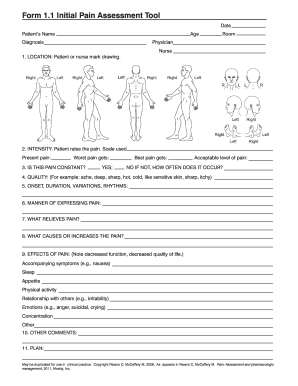
Get Pain Assessment And Documentation Tool 2020-2025
How it works
-
Open form follow the instructions
-
Easily sign the form with your finger
-
Send filled & signed form or save
How to fill out the Pain Assessment And Documentation Tool online
The Pain Assessment And Documentation Tool is essential for accurately documenting a patient's pain experience. This guide provides step-by-step instructions on how to effectively complete the form online, ensuring that users can provide comprehensive and clear information.
Follow the steps to complete the Pain Assessment And Documentation Tool.
- Click the ‘Get Form’ button to access the Pain Assessment And Documentation Tool and open it in your document editor.
- In the first section, enter the date, the patient's full name, age, and room number. Ensure that all personal information is accurate.
- Next, input the diagnosis in the designated field. This should reflect the patient's current health condition.
- Fill in the physician's name and the nurse's name in the corresponding fields to track the caring providers.
- For the pain location, have the patient or nurse indicate the specific areas on the provided drawing.
- In the intensity section, the patient should rate their pain using the specified scale. Record the present pain level, the worst pain they've experienced, the best pain level they recall, and what they consider an acceptable pain level.
- Determine if the pain is constant by checking 'yes' or 'no'. If the pain is not constant, specify how often it occurs.
- Describe the quality of the pain using suitable adjectives, such as 'sharp' or 'aching'.
- Document the onset, duration, variations, and rhythms of the pain experienced by the patient.
- Detail how the patient expresses their pain. Capture observable behaviors or descriptions the patient provides.
- Identify what relieves the pain for the patient by documenting any effective pain management strategies.
- List any triggers or factors that exacerbate the pain to aid in further pain management assessments.
- Note the effects of pain on the patient's overall functioning, including any accompanying symptoms, sleep issues, appetite changes, and emotional impact.
- In the 'Other comments' section, provide any additional information that might be relevant to the patient's pain experience.
- Finally, outline a pain management plan, detailing the strategies and interventions to be used moving forward.
Complete the Pain Assessment And Documentation Tool online today to ensure accurate documentation and effective pain management strategies.
The primary tool used for pain assessment is a standardized pain assessment tool, which can vary based on the setting and patient population. Many healthcare providers utilize the Pain Assessment And Documentation Tool for its ease of use and ability to gather accurate pain data efficiently. This tool enhances the overall quality of pain management by enabling more effective monitoring and documentation.
Industry-leading security and compliance
-
In businnes since 199725+ years providing professional legal documents.
-
Accredited businessGuarantees that a business meets BBB accreditation standards in the US and Canada.
-
Secured by BraintreeValidated Level 1 PCI DSS compliant payment gateway that accepts most major credit and debit card brands from across the globe.


